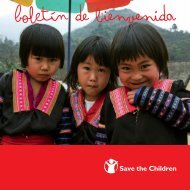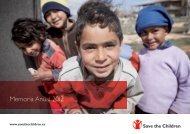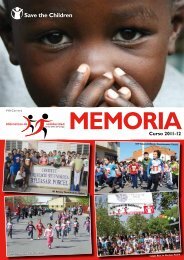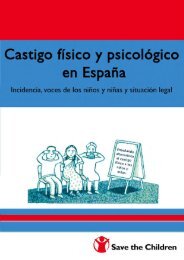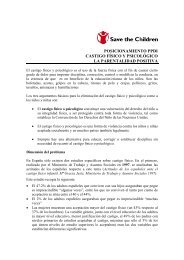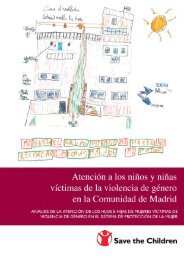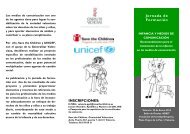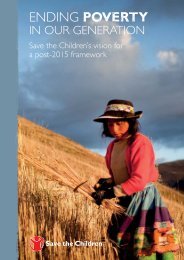Nutrition in the First 1,000 Days - Save the Children
Nutrition in the First 1,000 Days - Save the Children
Nutrition in the First 1,000 Days - Save the Children
You also want an ePaper? Increase the reach of your titles
YUMPU automatically turns print PDFs into web optimized ePapers that Google loves.
30 SaviNg liveS aND BUilDiNg a Better FUtUre: loW-coSt SolUtioNS that WorK<br />
with<strong>in</strong> an hour of birth; only 5 percent are exclusively breastfed for 6 months<br />
and 15 percent are breastfed with complementary foods between 6-9 months.<br />
At age 2, it is estimated that 27 percent of children are still gett<strong>in</strong>g some breast<br />
milk. Somalia has <strong>the</strong> lowest complementary feed<strong>in</strong>g rate and <strong>the</strong> highest child<br />
mortality rate <strong>in</strong> <strong>the</strong> world. Tragically, 1 child <strong>in</strong> 6 dies before reach<strong>in</strong>g age 5.93<br />
Years of political and economic <strong>in</strong>stability <strong>in</strong> Somalia have also contributed<br />
to severe <strong>in</strong>creases <strong>in</strong> stunt<strong>in</strong>g – up from 29 percent <strong>in</strong> 2<strong>000</strong> to 42 percent <strong>in</strong><br />
2006.94 Somalia has made no progress towards MDG 4.<br />
Côte d'Ivoire is ano<strong>the</strong>r country where conflict and <strong>in</strong>stability have created a<br />
dire situation for mo<strong>the</strong>rs and children. Only 25 percent of Ivorian newborns are<br />
put to <strong>the</strong> breast with<strong>in</strong> an hour of birth; only 4 percent are exclusively breastfed<br />
for 6 months; and 54 percent are breastfed with complementary foods between<br />
6-9 months. At age 2, it is estimated that 37 percent of children are still gett<strong>in</strong>g<br />
some breast milk. One child <strong>in</strong> 12 dies before reach<strong>in</strong>g age 195 and 39 percent<br />
of children are stunted. Côte d'Ivoire has made <strong>in</strong>sufficient progress towards<br />
MDG 4, and has taken little action on <strong>the</strong> International Code of Market<strong>in</strong>g of<br />
Breast-milk Substitutes.<br />
In Botswana, breastfeed<strong>in</strong>g was once widely practiced96 but today, only<br />
20 percent of <strong>in</strong>fants are exclusively breastfed. Botswana has been hard hit by<br />
AIDS, and many <strong>in</strong>fected mo<strong>the</strong>rs likely do not breastfeed for fear <strong>the</strong>y might<br />
pass along <strong>the</strong> disease to <strong>the</strong>ir babies. However, if given <strong>the</strong> right treatment with<br />
antiretrovirals (ARVs), HIV-positive mo<strong>the</strong>rs can safely breastfeed.97 And even<br />
without ARVs, <strong>in</strong> places where <strong>the</strong>re is little access to clean water, sanitation or<br />
health services, <strong>the</strong> risk that a child will die of diarrhea or ano<strong>the</strong>r childhood<br />
disease outweighs <strong>the</strong> risk of contract<strong>in</strong>g HIV through breast milk, at least<br />
dur<strong>in</strong>g <strong>the</strong> early months. Most HIV-positive mo<strong>the</strong>rs <strong>in</strong> develop<strong>in</strong>g countries<br />
are advised to exclusively breastfeed, but this message has met resistance <strong>in</strong><br />
Botswana. Poorly tra<strong>in</strong>ed health workers often do not encourage this recommended<br />
practice. And despite good efforts by <strong>the</strong> government to discourage<br />
formula feed<strong>in</strong>g by enact<strong>in</strong>g most of <strong>the</strong> Code <strong>in</strong>to law, <strong>the</strong> policies and programs<br />
to ensure that HIV-positive mo<strong>the</strong>rs are <strong>in</strong>formed about <strong>the</strong> risks and<br />
benefits of different <strong>in</strong>fant feed<strong>in</strong>g options – and are supported <strong>in</strong> carry<strong>in</strong>g out<br />
<strong>the</strong>ir <strong>in</strong>fant feed<strong>in</strong>g decisions – rema<strong>in</strong> <strong>in</strong>adequate.98 Largely as a result, only 20<br />
percent of Botswana’s newborns are put to <strong>the</strong> breast with<strong>in</strong> an hour of birth. At<br />
ages 6-9 months, 46 percent are breastfed with complementary foods and at age<br />
2, only 6 percent of children are gett<strong>in</strong>g any breast milk at all. Botswana’s <strong>in</strong>fant<br />
mortality rate is 36 per 1,<strong>000</strong> live births and 31 percent of children are stunted.<br />
Equatorial Gu<strong>in</strong>ea is <strong>the</strong> highest <strong>in</strong>come country <strong>in</strong> Africa, demonstrat<strong>in</strong>g<br />
that national wealth alone is not sufficient to prevent malnutrition. Only 24<br />
percent of babies <strong>in</strong> Equatorial Gu<strong>in</strong>ea are exclusively breastfed for 6 months<br />
and 48 percent are breastfed with complementary foods between 6-9 months.<br />
At age 2, it is estimated that just 10 percent of children are still gett<strong>in</strong>g some<br />
breast milk. Equatorial Gu<strong>in</strong>ea has made <strong>in</strong>sufficient progress towards MDG 4,<br />
and has taken no action on <strong>the</strong> International Code of Market<strong>in</strong>g of Breast-milk<br />
Substitutes. One child <strong>in</strong> 12 dies before reach<strong>in</strong>g age 199 and 35 percent of children<br />
have stunted growth.<br />
côte d’ivoire






